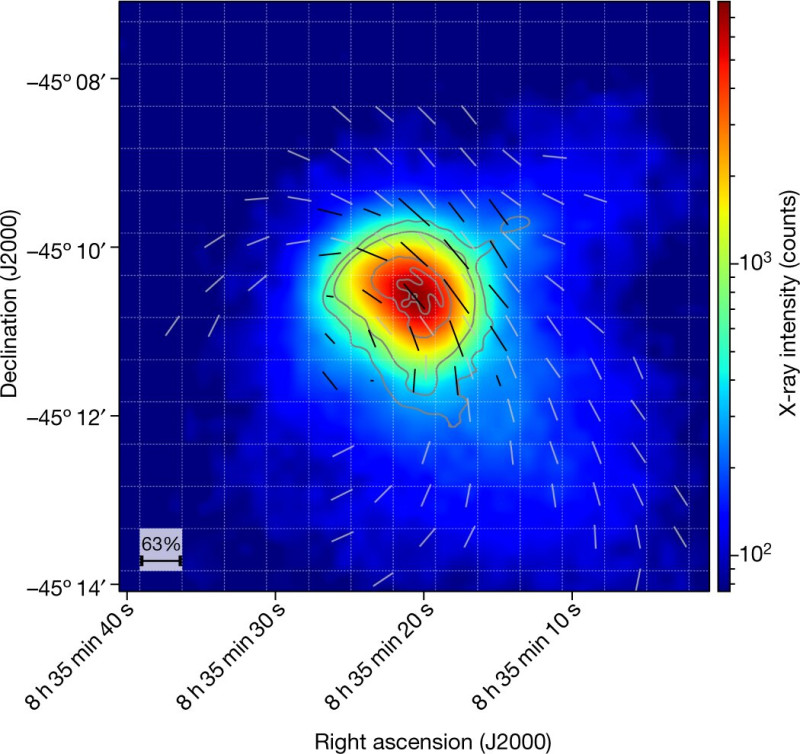The Vela pulsar, located about 1,000 light-years from Earth, is about 15 miles (25 kilometers) in diameter and rotates 11 times per second
An amazing image from a supernova that occurred 10,000 years ago and “reached” Earth, NASA recorded. Within the enormous dimension phenomenon that developed in the Vela Nebula, the NASA discerned the creation of a Pulsar, which is one of the greatest mysteries in space exploration.
The supernova left behind a dense object called a pulsar, which appears to glow regularly as it spins, like a cosmic beacon. From the surface of this pulsar, winds of particles traveling at near the speed of light emerge, creating a chaotic hood of charged particles and magnetic fields that collide with the gaseous environment. This phenomenon is called the pulsar wind nebula.
In this new image, the hazy blue halo corresponds to the first X-ray polarization data for Vela, which came from NASA’s Imaging X-ray Polarimetry Explorer, or IXPE. A faint blue fuzzy line pointing in the upper right corner corresponds to a jet of high-energy particles ejected from the pulsar at about half the speed of light. The pink X-ray “bows” are thought to mark the edges of regions where the pulsar wind shocks and accelerates high-energy particles. The pulsar itself is in the white circle in the center of the image.
See the picture:
The pink and purple colors correspond to data from NASA’s Chandra X-ray Observatory, which has observed the Vela Nebula several times before. The golden stars were captured by NASA’s Hubble Space Telescope.
Measuring polarization, which is about how electromagnetic waves are organized, gives scientists an unprecedented understanding of how a cosmic object such as a pulsar accelerates particles to high speeds.
In a recent study, scientists were surprised at the high degree of polarization they found in the X-rays in the Vela pulsar wind nebula. The IXPE observations of this object were published in the journal Nature in December.
“This is the highest degree of polarization measured in a celestial X-ray source to date,” said Fei Xie, lead author of the Nature study, a professor at Guangxi University in Nanning, Guangxi, China, and a former postdoctoral researcher at the National’s National Institute of Astrophysics/Institute of Space Astrophysics and Planetology (INAF/IAPS) in Rome.
High polarization means that electromagnetic fields are well organized. They line up in specific directions and depend on their position in the nebula. Additionally, the X-rays detected by IXPE come from high-energy electrons spiraling through the magnetic fields of the pulsar wind nebula. The highly polarized X-rays mean that these magnetic fields must also be well organized.
The Vela pulsar, located about 1,000 light-years from Earth, is about 15 miles (25 kilometers) in diameter and rotates 11 times per second.
About the IXPE mission
Part of NASA’s Small Explorer mission series, IXPE launched on a Falcon 9 rocket from NASA’s Kennedy Space Center in Florida in December 2021. It now orbits 370 miles, or about 595 kilometers, above Earth’s equator. The mission is a collaboration between NASA and the Italian Space Agency, with collaborators and scientific collaborators in 13 countries.
Source :Skai
I am Terrance Carlson, author at News Bulletin 247. I mostly cover technology news and I have been working in this field for a long time. I have a lot of experience and I am highly knowledgeable in this area. I am a very reliable source of information and I always make sure to provide accurate news to my readers.











